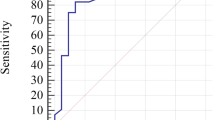Abstract
Tissue Doppler imaging (TDI) can detect myocardial dysfunction related to iron load in patients with beta-thalassemia major (TM). We aimed to assess the efficacy of pulsed-wave TDI (PW-TDI) in predicting myocardial iron load in patients with TM using T2* magnetic resonance (MR) as the gold-standard non-invasive diagnostic test. 33 asymptomatic TM patients, mean aged 18 ± 6 years (6–31) with normal left ventricular (LV) global systolic function were evaluated by conventional echocardiography and PW-TDI. Results were compared with 20 age and sex-matched controls. TDI measures included myocardial systolic (Sm), early (Em) and late (Am) diastolic velocities at basal and middle segments of septal and lateral LV wall. Myocardial iron deposition were measured in 29/33 patients by T2* MR. TM patients were also subgrouped according to those with iron load (T2* ≤ 20 ms) and those without (T2* > 20 ms). Mean T2* was 12.3 ± 7.8 ms (4–31.3). Abnormal myocardial iron load (T2* < 20 ms) was found in 25/29 (86%) patients. The following TDI measures were lower in patients than in controls: basal septal Em (P < 0.001) and Am (P < 0.05), mid-septal Am (P < 0.05), mid-lateral LV wall Sm (P < 0.05) and Am (P < 0.05). Regional myocardial dysfunction were more prominent in patients with T2* ≤ 20 ms. Mid-septal Sm and Em significantly correlated with mid-septal T2*(r = 0.44, P = 0.023 and r = 0.54, P = 0.004, respectively). The PW-TDI parameters and the cut-off values for predicting presence of myocardial iron load were determined. PW-TDI technique was found both sensitive and specific in predicting presence of myocardial iron load in TM patients with normal LV global systolic function. Therefore, it can be used for screening of TM patients.


Similar content being viewed by others
References
Walker JM (2002) The heart in thalassaemia. Eur Heart J 23:102–105. doi:10.1053/euhj.2001.2850
Borgna-Pignatti C, Cappellini MD, De Stefano P et al (2006) Cardiac morbidity and mortality in deferoxamine- or deferiprone-treated patients with thalassemia major. Blood 107:3733–3737. doi:10.1182/blood-2005-07-2933
Kolnagou A, Kontoghiorghes GJ (2006) Effective combination therapy of deferiprone and deferoxamine for the rapid clearance of excess cardiac IRON and the prevention of heart disease in thalassemia. The protocol of the international committee on oral chelators. Hemoglobin 30:239–249. doi:10.1080/03630260600642567
Mavrogeni SI, Gotsis ED, Markussis V et al (1998) T2* relaxation time study of iron overload in beta-thalassemia. MAGMA 6:7–12
Anderson LJ, Holden S, Davis B et al (2001) Cardiovascular T2-star (T2*) magnetic resonance for the early diagnosis of myocardial iron overload. Eur Heart J 22:2171–2179. doi:10.1053/euhj.2001.2822
Pennell DJ (2005) T2* magnetic resonance and myocardial iron in thalassemia. Ann N Y Acad Sci 1054:373–378. doi:10.1196/annals.1345.045
Pepe A, Positano V, Santarelli MF et al (2006) Multislice multiecho T2* cardiovascular magnetic resonance for detection of the heterogeneous distribution of myocardial iron overload. J Magn Reson Imaging 23:662–668. doi:10.1002/jmri.20566
Vogel M, Anderson LJ, Holden S et al (2003) Tissue Doppler echocardiography in patients with thalassaemia detects early myocardial iron dysfunction related to myocardial iron overload. Eur Heart J 24:113–119. doi:10.1016/S0195-668X(02)00381-0
Hamdy AM (2007) Use of strain and tissue velocity imaging for early detection of regional myocardial dysfunction in patients with beta thalassemia. Eur J Echocardiogr 8:102–109. doi:10.1016/j.euje.2006.02.004
Magrì D, Sciomer S, Fedele F et al (2008) Early impairment of myocardial function in young patients with beta-thalassemia major. Eur J Haematol 80:515–522. doi:10.1111/j.1600-0609.2008.01054.x
Silvilairat S, Sittiwangkul R, Pongprot Y et al (2008) Tissue Doppler echocardiography reliably reflects severity of iron overload in pediatric patients with beta thalassemia. Eur J Echocardiogr 9:368–372. doi:10.1016/j.euje.2007.06.003
Parale GP, Pawar SS, Tapare VS (2009) Assessment of LV diastolic function in patients with beta-thalassemia major with special reference to E/Eann ratio. J Pediatr Hematol Oncol 31:69–73. doi:10.1097/MPH.0b013e31818ab138
Uçar T, Ileri T, Atalay S et al (2009) Early detection of myocardial dysfunction in children with beta-thalassaemia major. Int J Cardiovasc Imaging 25:379–386. doi:10.1007/s10554-008-9404-3
Sahn DJ, De Maria A, Kisslo J, Weyman A (1978) The committee on M-mode standardization of the American society of echocardiography: results of a survey of echocardiographic measurements. Circulation 58:1072–1083
Quňones MA, Otto CM, Stoddard M et al (2002) Recommendation for quantification of doppler echocardiography: a report from the doppler quantification task force of the nomenclature and standards committee of the American society of echocardiography. J Am Soc Echocardiogr 15:167–184. doi:10.1067/mje.2002.120202
Barosi G, Arbustine E, Gavazzi A et al (1989) Myocardial iron grading by endomyocardial biopsy. A clinico-pathologic study on iron overloaded patients. Eur J Haematol 42:382–388
Karvounis HI, Zaglavara TA, Parharidis GE et al (2001) An angiotensin converting enzyme inhibitor improves left ventricular systolic and diastolic function in transfusion-dependent patients with beta-thalassemia major. Am Heart J 141:281. doi:10.1067/mhj.2001.112090
Aessopos A, Farmakis D, Hatziliami A et al (2004) Cardiac status in well-treated patients with thalassemia major. Eur J Haematol 73:359–366. doi:10.1111/j.1600-0609.2004.00304.x
Kremastinos DT, Tsiapras DP, Tsetsos GA et al (1993) Left ventricular diastolic Doppler characteristics in beta-thalassemia major. Circulation 88:1127–1135
Weidemann F, Eyskens B, Sutherland GR (2002) New ultrasound methods to quantify regional myocardial function in children with heart disease. Pediatr Cardiol 23:292–306. doi:10.1007/s00246-001-0195-8
Author information
Authors and Affiliations
Corresponding author
Rights and permissions
About this article
Cite this article
Aypar, E., Alehan, D., Hazırolan, T. et al. The efficacy of tissue Doppler imaging in predicting myocardial iron load in patients with beta-thalassemia major: correlation with T2* cardiovascular magnetic resonance. Int J Cardiovasc Imaging 26, 413–421 (2010). https://doi.org/10.1007/s10554-010-9591-6
Received:
Accepted:
Published:
Issue Date:
DOI: https://doi.org/10.1007/s10554-010-9591-6




